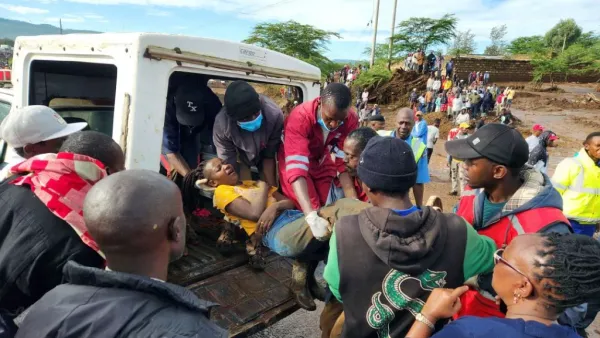Mai Mahiu, Kenya - Earlier today, the Old Kijabe Dam in western Kenya's Great Rift Valley region succumbed to the relentless pressure of ongoing heavy rains, collapsing and unleashing a devastating flood that claimed at least 40 lives and wrought extensive destruction.
The disaster cut off a major road and left a trail of debris, mud, and uprooted trees, severely impacting the local community and transportation.
Stephen Kirui, a police official, reported to the Associated Press that the floodwaters swept through residential areas, dragging vehicles into the chaos and leaving paramedics to tend to numerous injuries. The affected area, known for its susceptibility to flash floods, was overwhelmed as the dam's waters surged downstream.
This tragic incident is part of a broader crisis in Kenya, which has been grappling with severe flooding since mid-March due to unrelenting rains.
The Meteorology Department has issued warnings of more rainfall to come, heightening the urgency of response and preparedness measures.
In response to the disaster, Interior Minister Kithure Kindiki has mandated a comprehensive inspection of all public and private dams and water reservoirs across the country.
This directive, effective from today afternoon, aims to prevent further such incidents by assessing structural integrity and potential risks. The results of these inspections are expected to guide immediate evacuations and resettlement recommendations.
The Kenya National Highways Authority has also issued an alert, advising motorists of heavy traffic and obstructions due to debris blocking major roads.
The situation is exacerbated by the wider East African region's ongoing struggle with flooding, which has claimed lives and displaced thousands in neighbouring countries, including Tanzania and Burundi.
Adding to the country's woes, a boat capsized in northern Garissa county on Sunday night, leading to over a dozen people missing, despite the Kenyan Red Cross's rescue efforts of 23 individuals.
Moreover, flooding at Kenya’s main airport on Saturday disrupted flight operations, with social media circulating dramatic footage of the inundated facilities.
My thoughts and prayers are with the Kenyans who are going through a traumatic time this weekend due to floods.
— Hopewell Chin’ono (@daddyhope) April 28, 2024
Over 80 Kenyans have been killed by these floods, which have immobilised Kenya’s Jomo Kenyatta International Airport.
These floods are being caused by the Indian… pic.twitter.com/bRW5qgPbye
The cumulative impact of the floods has been staggering, with over 200,000 Kenyans affected. Many have been forced to evacuate their homes, seeking refuge in schools and other makeshift shelters.
President William Ruto has directed the National Youth Service to allocate land for temporary camps to accommodate those displaced by the ongoing calamity.
As the nation confronts these challenging times, the government's proactive steps and the community's resilience are crucial in navigating the aftermath of this natural disaster and mitigating future risks.


Related News
Kenyans Face Increased Tax Burden Under President Ruto's Economic Plan
Jun 08, 2024
Kenya's Rhonex Kipruto Banned for Six Years for Doping Violation, Loses World Records and Medals
Jun 06, 2024
Kenyan President Seeks Guidance from Evangelical Pastors for Upcoming Haiti Mission
Jun 05, 2024